Acute
The Barnet Union workhouse was built during 1836 and 1837 on part of Barnet Common on the south side of Wellhouse Lane. It opened in 1838 and had accommodation for about 200 inmates.
An infirmary block was built in 1886 to the east of the workhouse, and another one was added to the south in 1901.
In 1915 Pickering Lodge, a mansion adjacent to the workhouse, was acquired at a reasonable price for use as a Nurses' Home for the Infirmary. It had an ornamental garden and a tennis lawn.
Despite the outbreak of WW1 in 1914, the Barnet Guardians had begun to build a new infirmary early in 1915, but the work had to be postponed because of shortage of manpower. However, the Army Council took over the project and completed the infirmary in June 1916, when it became the Barnet War Hospital.
Between the years 1916 and 1918 some 6,000 wounded and sick soldiers were treated at the Hospital.
In October 1919 the infirmary was handed back to the Guardians, who were able to purchase all the equipment from the War Office for 10% less than it had cost in 1915.
The Guardians renamed it the Wellhouse Hospital (centuries ago the site had contained a physic well - Samuel Pepys used to partake of its waters).
The Wellhouse Hospital had 204 beds and consisted of a 3-storey block with six wards, including a maternity ward and labour ward with nine beds. The building was designed to be extended eventually to 600 beds.
The wards were distempered in a soft shade of green. Each had a Day Room attached which was furnished with comfortable easy chairs, by courtesy of the Army Council. On the south side of the building, verandahs led out from the wards, affording patients an unsurpassed view of the countryside. The Guardians proposed to make spare beds available to private patients, an innovation in a Poor Law hospital.
The operating theatre and the dispensary were most modern. The kitchen was magnificent and was worked by steam; it was equipped with hot plates and every device to ensure the comfort of the patients.The Hospital was officially opened in November 1920 by the Lord Lieutenant of Hertfordshire, Lord Hampden (1869-1958). Patients had been transferred from the old building some two days before, but the ceremony took place in one of the empty wards on the top floor.
In 1922 the Guardians set aside a ward for paying patients, who were charged a minimum of 2 guineas (£2.10) a week.
In 1930 Hertfordshire County Council took over administrative control of the workhouse and the Hospital when the Poor Law Unions and Boards of Guardians were abolished following the Local Government Act, 1919. The workhouse was renamed the Wellhouse Public Assistance Institution (PAI).
In 1939, at the outbreak of WW2, the PAI was closed and the majority of the inmates transferred to other institutions outside London (except for eight old men who had lived in the institution for most of their lives and were allowed to remain).
The Hospital took over the buildings and the site became the Advanced Base for St Bartholomew's Hospital and the Royal Free Hospital under the Emergency Medical Scheme (EMS). It had 396 beds and was augmented by 692 EMS beds in hutted wards. Patients from the Elizabeth Garrett Anderson Hospital were evacuated here from central London.
After the war the Hospital joined the NHS in 1948 under the control of the Barnet Group Hospital Management Committee, part of the North West Metropolitan Regional Hospital Board.
The eight elderly male patients who had been allowed to live in the Hospital during the war were compulsorily rehoused in Western House, a County Council institution in Ware, Herts.
The Hospital Management Committee took stock
of their acquisition. The former PAI was described as having been
"built with the solidity, but not the dignity, of a fortress".
The main building, which backed onto Wellhouse Lane, had a
T-shaped layout, with deep wings containing back-to-back wards.
Various out-buildings, workshops and wash-houses were located at
the northern and southern edges of the site. The EMS beds with
their horsehair mattresses had outlived their usefulness. The
ward furniture and equipment was poor and outdated, the kitchen was
inadequate and the pharmacy so congested as to be a danger. The
Out-Patients Department and its clinics were hopelessly overcrowded
(there was no appointments system) and the staff residences dingy and
untidy. There was only one bedpan washer in the whole of the
Hospital.
During 1948 the rooms in the buildings along Wellhouse Lane were
cleared of patient use, and became offices, storage rooms and modern
clinics. The wards were redecorated and re-equipped with new
furniture and beds with spring mattresses. Bedpan washers were
installed in each ward. The kitchen was extended and new
electrically-heated trolleys were purchased to convey food from the
kitchens to the wards. The allowance of 11 shillings (55p) a week
for each patient's food was doubled. New side wards were built
for patients needing privacy. A new pharmacy and a modern
pathology laboratory were opened in the autumn of 1948.
New clinics were opened and an appointments system established on 1st January 1949. The residential accommodation for medical, nursing and domestic staff was remodelled and re-equipped.
In 1949 the maternity unit moved to the Victoria Cottage Hospital in Wood Street, which was renamed the Victoria Maternity Hospital. The former Barnet Isolation Hospital reopened as St Stephen's Hospital, an annexe to the Wellhouse Hospital.
In 1950, when the Hospital had 475 beds, it was renamed Barnet General Hospital to indicate its change of status and to distance it from its previous status as a Public Assistance Institution (these failed to attract nursing staff because of their preponderance of chronically sick patients). Staff shortages at the Hospital had caused four wards to be closed, although one reopened later when ward orderlies were recruited.
In 1953, the year of the Coronation, a member of the television trade temporarily installed TV sets in the wards so that the patients could watch the ceremony.In the mid 1950s new Out-patients and Casualty Departments were built at a cost of £87,000. The building was officially opened in March 1956 by the Minister of Health, R.H. Turton (1903-1994). By then the Hospital had 461 beds, some still in the EMS hutted wards.
In 1957 the Barnet Ventilator was produced commercially. It had been developed at the Hospital by Dr J.D. Rochford, Dr R.F. Welch and Mr D. Winks as "an alternative to an iron lung" for patients with depressed breathing due to polio or other cause (barbiturate poisoning, severe head injury or lung disease) or during lung operations when curare-like drugs were used.
A Recovery Ward (post-anaesthetic room) opened in 1958 for the reception of patients from the operating theatre.
At the beginning of the 1960s the Hospital still suffered from a shortage of nurses, almoners, physiotherapists, radiographers and catering staff, blamed mostly on the poor wages paid by the NHS. In 1961 a Recreation Hall was built with funds from the King's Fund to improve staff amenities. A hostel for the nursing staff was built, as well as an extension to the Sisters' Home, and improvements made to the hutted wards. By 1964 the Hospital had 490 beds. In January 1965 a new Radio-Isotope Unit opened.
By 1966 the Hospital had 471 beds and, in 1974, 438 beds.
Following a major reorganisation of the NHS in 1974 it came under the control of the Barnet and Finchley District Heath Authority, part of the North West Thames Area Health Authority.
In 1990, while visiting the Hospital, the Prime Minister, Margaret Thatcher, announced that the Department of Health had approved its three-stage redevelopment plans and that work would begin in 1991 under a PFI agreement with the consortium Metier Healthcare.
The first phase of the £90m project involved building a new maternity unit, which was completed in March 1997. This was followed by the erection of a surgical block with six operating theatres, an Accident & Emergency Department, an X-ray Department and a day surgery unit. The second phase saw the demolition of the old hutted wards. The final phase was the building of new permanent buildings to house the wards and the Out-Patients Department with supporting services.
In 1999 the Wellhouse Trust merged with Chase Farm Hospital Trust to become the Barnet and Chase Farm Hospitals NHS Trust. Some services were relocated to the Chase Farm Hospital site.
The new Hospital with 459 beds was completed in 2002 and officially opened by the Princess Royal in February 2003. In the same year the Hospital dropped the word 'General' from its title, becoming simply Barnet Hospital.
In 2005 the Hospital had 445 beds (out of the 954 available in the Trust).Despite protests from local historians and residents, the workhouse buildings were demolished to make way for a car park, as yet uninstalled.
Present status (June 2008)
The site of the old workhouse buildings remains a wasteland, while the buildings on the west side of the new Hospital are largely derelict.
The Hospital charges both visitors and patients £4 for two hours parking.

Barnet Hospital.
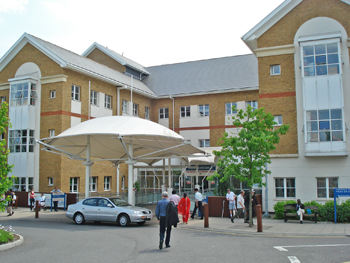
The main entrance.

The Hospital is surrounded by a sea of cars.


Wasteland on the northeast side, fenced off along Wellhouse Lane (above and below). This is the site of the workhouse buildings.
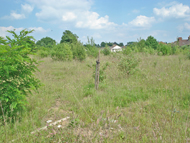
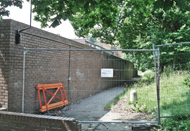
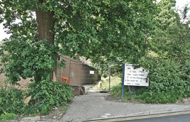
The buildings on the west side of the site across Wellhouse Lane, appear to be derelict. One of them, Elmbank House, closed in 2004.
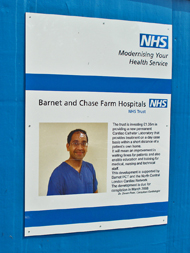
Signage announcing a new Cardiac Centre.
(Author unstated) 1916 Nursing echoes. British Journal of Nursing 15th April, 346.
(Author unstated) 1916 Nursing echoes. British Journal of Nursing 2nd September, 196.
(Author unstated) 1920 Wellhouse Hospital. British Journal of Nursing 27th November, 301-302.
(Author unstated) 1921 Wellhouse Hospital, Barnet. British Medical Journal 1 (3143), S81.
Rochford J, Welch RF, Winks DP 1958 An electronic time cycled respirator. British Journal of Anaesthesia 30, 23-31.
http://rcnarchive.rcn.org.uk
www.barnet.gov.uk
www.bhfriends.co.uk
www.chasefarmhospital.org.uk
www.geograph.org.uk
www.nationalarchives.gov.uk
www.theyworkforyou.com
www.workhouses.org.uk
Return to home page